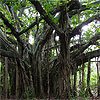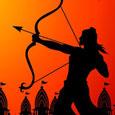Indian National Symbols
National Emblem The national emblem comes from the Sarnath Lion Capital of Emperor Ashoka. Ashoka
ruled the land from 272 BCE to 232 BCE. The original sculpture shows four lions
on a pillar with an elephant, horse, bull, and lion separated by a lotus on the
base. A Dharma Chakra (wheel of law) is also carved into the stone.
The emblem was adopted on January 26, 1950 by the Indian Government. The official symbol
now shows three of the four lions with the Dharma Chakra in the center of the
base and a bull and horse on either side. The base is also engraved with the phrase
"Satyameva Jayate" in the Devanagari script of India. This simple phrase
represents a powerful idea for the Indian people: "Truth alone triumphs".
National Animal Tiger (Panthera Tigris, Linnaeus) is the national animal of India. Tiger is also known as the
lord of Jungles. The tiger is symbolic of India's wildlife wealth. The rare combination
of grace, strength, agility and enormous power has earned the tiger great respect
and high esteem. India is home to nearly half of the total population of tigers.
National Bird
The Peacock, Pavo cristatus (Linnaeus), is the national bird of India. The peacock symbolizes
qualities like beauty, grace, pride and mysticism. Peacock is a colorful, swan-sized
bird, with a fan-shaped crest of feathers, a white patch under the eye and a long,
slender neck. The male of the species is more colorful than the female, with
a glistening blue breast and neck and a spectacular bronze-green train of around
200 elongated feathers they spread out in display at the onset of the monsoons.
The female is brownish in color, slightly smaller than the male, and lacks the
train. Peacocks have a harsh voice, which is a stark contrast to their beauty.
The elaborate courtship dance of the male, fanning out the tail and preening its
feathers is a beautiful sight. Peacock is the sacred bird of the India, protected
not only by the religious sentiment but also by parliamentary statute.

National Calendar of India
The national calendar of India is based on the Saka Era with Chaitra as the first
month and a normal year of 365 days. The national calendar of India was adopted
on March 22nd 1957. Dates of the Indian national calendar have a permanent correspondence
with the Gregorian calendar dates- 1 Chaitra normally falls on 22 March and on
21 March in leap year.
The national Calendar of India is used along with the
Gregorian calendar for the following official purposes- (i) Gazette of India,
(ii) news broadcast by All India Radio, (iii) calendars issued by the Government
of India and (iv) Government communications addressed to the members of the public.
The Indian Tricolour
The Indian flag is rectangular in shape and is made up of three horizontal breadths
of Saffron, White and Green. The Saffron stands for courage and sacrifice, White
for purity and Green for fertility. There is a wheel with 24 spokes in the middle
of the white colored portion of the flag. The wheel represents the Dharma Chakra.
National Flower
Lotus (Nelumbo Nucifera) is the National Flower of India. On the virtue of being a sacred flower,
it occupies a unique position in the art and mythology of ancient India and has
been an auspicious symbol of Indian culture since time immemorial. The Lotus
symbolizes divinity, fertility, wealth, knowledge and enlightenment. The flower grows in
murky waters and rises on a long stalk above the surface to bloom. It represents
long life, honor, and good fortune.

Lotus is also symbolic of the purity of heart and mind. The lotus holds additional significance for Hindus, as it is a
symbol of God and used often in religious practices. According to the popular
Indian thought, there is the last and final lotus - Charan Kamal or lotus feet
of the Almighty. It was this depth of thought that made the founding fathers of
modern India enshrine the lotus in the Constitution as the National Flower. National
Fruit of India Mango (Mangifera Indica) is the National fruit of India. In India, mango is cultivated
almost in all parts, except the hilly areas. Mango is a rich source of Vitamins
A, C and D. In India, we have hundreds of varieties of mangoes. They are of different
sizes, shapes and colors. Even in our mythology and history there are stories
of mangoes- the famous Indian poet Kalidasa sang its praise. Alexander the great,
along with Hieun Tsang savored the taste of mangoes. The great Mughal king, Akbar
is said to have planted over 100,000 mango trees in Darbhanga (modern Bihar).
The mango is eaten ripe and is also used to make pickles.
The National Tree of India
The National tree of India is the banyan.
This huge tree towers over its neighbors and has the widest reaching roots of all known trees, easily covering several
acres. It sends off new shoots from its roots, so that one tree is really a tangle
of branches, roots, and trunks. The banyan tree regenerates and beats all other
tree in its longevity. It is thought to be the immortal tree. Its size and leafy
shelter are valued in India as a place of rest and reflection, not to mention
protection from the hot sun! India has a long history of honoring this tree; it
figures prominently in many of the oldest stories of the nation.

National Game of India
Hockey, which has been played in India since time immemorial, is the National Game of India.
There was a golden period of Indian hockey when hockey stalwarts of India ruled
the game. On the international scenario there were no competitors to match the
magic of Indian hockey players. The unmatched excellence and incomparable talent
of Indian players became folklore. The ball-juggling feats of players like Major
Dhyanchand made people think that Indian players used some underhand means. The
Golden Era of hockey in India was the period from 1928 - 1956 when India won 6
successive gold medals in the Olympic Games.

National Fruit of India
The Mango is the national fruit of India. A favourite of most Indians, this
fruit has been cultivated in the country since ancient times.
There are over 100 types of mangoes in India, of various colors, sizes, and shapes.
Common in the tropical part of the world, mangoes are liked hugely and relished
for their sweet juice and bright colors. Rich in vitamin A, C, and D, mangoes
are also useful for health.

Indians eat mangoes ripe, or prepare them green as pickles or chutneys
(condiments). The poet Kalidasa sang its praises in his immortal works. Akbar
planted 100,000 mango trees in Darbhanga, known as Lakhibagh. Even well-known
visitors to India, like Alexander and Hieun Tsang, were generous in their
appreciation for Indian mangoes.
National Song of India
The composition "Vande Mataram", hailed as the National Song of India,
eulogizes India as a Goddess and glorifies Indian patriotism in a beautiful
manner. Composed originally in Sanskrit by Shri Bankim Chandra Chattyopaddhay,
the song first appeared in the ace novelist's Bengali novel 'Anand Math'
(published in 1882) and was a source of inspiration to the Indian people in
their struggle for freedom. The English translation of the song, rendered by
Shree Aurobindo, is considered to be the official and best. The first stanza of
this song has been given the status of India's national song.
"Vande Mataram" has an equal status with "Jana Gana Mana", the Indian National
Anthem composed by Nobel Laureate Rabindranath Tagore. The song, in fact, was
originally designated as the National Anthem. The first political occasion when
it was sung was the 1896 session of the Indian National Congress.
Interestingly, the music for this song had been composed by none other than
Rabindranath Tagore.
To read the lines of "Vande Mataram", click here.
National Animal of India
The National animal of India is the magnificent creature called The Royal Bengal
Tiger, whose scientific name is "Tiger Panthera tigris". A bright yellow-coloured
well-striped animal with a short coat, the Bengal Tiger occupies a variety of
habitats from dry open jungles, humid ever-green forests to mangrove swamps.
The combination of grace, strength, agility and enormous power has earned the
tiger its pride of place as the national animal of India. It stands as a symbol
of India's wealth of wildlife. The Royal Bengal Tiger is found throughout the
country except in the north-western region and also in the neighbouring
countries, Nepal, Bhutan and Bangladesh.

National Anthem of India
The song "Jana Gana Mana", composed originally in Bengali by Rabindranath
Tagore, was adopted in its Hindi version by the Constituent Assembly as the
national anthem of India on 24 January 1950. It was first sung on 27 December
1911 at the Calcutta Session of the Indian National Congress. Before this, the
National Anthem of India was Bankim Chandra's song "Vande Mataram".
Though the complete song consists of five stanzas, only the first of the five
stanzas of "Jana Gana Mana" was designated as the anthem. The first stanza
contains the full version of the National Anthem. A formal rendition of the
national anthem takes about forty-eight to fifty-two seconds. A shortened
version consisting of the first and last lines (and taking about 20 seconds to
play) is also played on certain occasions. It is commonly sung by Indians in
unison at public events, schools and colleges during the Independence Day and
Republic Day Celebrations.
To read the lines of "Jana Gana Mana", click here.
National Pledge
The Indian National Pledge is an oath of allegiance to the Republic of India.
It is commonly recited by Indians in unison at public events, during daily
assemblies in many Indian schools, and during the Independence Day and Republic
Day Observance Ceremonies.
To know more, click here








 Ram Navami
Ram Navami Passover
Passover Good Morning
Good Morning